Monday – Berkshire – We return home after a family event, Great Nephew (I think) Finn’s Naming Day. We are delayed as the car starter motor packed up yesterday. The rescue service rather cleverly, I thought, pulled the car up the slope of their lorry, then rolled it off to bump start it, which was successful. This morning we find a garage that can do the job today. It is hidden away down a track in Bisley. I manage to pass the lane then stall the car turning around. I almost do a “Fawlty Towers” and start beating the car, although it is my own stupid fault! After some hours we are on our way. Three Red Kites are near the M4/A329M junction; we saw none on the way here yesterday.
Wednesday – Bodenham Lake – I collect the first rucksack full of windfall cider apples – Dabinett, Blanc Mollet and Kingston Blacks. A Common Buzzard and several House Martins are high over Westfield Wood. The lake is quiet. A single duck Mallard is on the scrape with more on the far side. A couple of Cormorants, a few Canada Geese, mute Swans and the lone Great Crested Grebe in its usual spot at the south end. There is a gusting wind and bright sunshine. Rooks caw in the distance. A large party of Coots, sixteen swim to and fro. Leaves are yellowing rapidly now.
Friday – Weobley – Out of the car park and past Marlbrook House. Timbers in this house have been dated to 1494. It has bargeboards with a cusped decoration on the gable on the front of the building which dates from the time the first stage of the building was constructed in the late 15th century. A carriage arch is a later addition. Turning the corner the road passes over the Marlbrook which emerges from an underground channel briefly before disappearing again. It is cool and damp. If the weather forecast is to be believed, this is a lull before a storm hits us. Mistle Thrushes rasp, Wood Pigeons and Jackdaws sit and watch. Above the remains of the castle moat, a Robin sings from a dead tree. Over the field where once lay the fish stews for the castle. The next field has been harvested of potatoes. Oddly quite a large number still lay on the surface, which is slick, red clay with plenty of laying water. Over a hundred Rooks seek bugs, more fly around trees cawing. A Great Tit calls from a large Oak. A Rook circles above yelping like a Herring Gull! Back towards the castle via a field to the west of the stews. It is sown with winter wheat and green shoots cover the soil.
Home – A gallon of juice was extracted from the apples and the demi-john has been put in the garage for fermentation. Only one of the hens is laying, the other is looking very sorry for herself. She may simply be in moult or she may be unwell – time will tell. A couple of kilos of pickling onions have been purchased from the greengrocer and they are now in brine prior to pickling. I need to bring some apples in for storage very soon. Blackbirds are feasting on the windfalls. In fact, there are a number of jobs that need doing – compost bins to be emptied into the big bins, ground prepared for garlic sowing, climbing beans need cropping and drying, greenhouse needs a lot of work... Unfortunately, my inflamed shoulder tendon is making things difficult.
Monday – Croft Ambrey – It is a true autumn day – cool, misty and rain falling. A Robin sings despite the inclement weather. Few leaves have fallen yet. The pools are copper carbonate blue from decaying vegetation. Water can be heard flowing out of them via the overflow channels. The Robin’s song turns to ticking. The rain gets heavier. The condition of the path up out of the valley has deteriorated considerably over recent years with deep gouges and lots of loose stone caused by the water flow following the prolonged wet periods. Unsurprisingly, the view from Croft Ambrey is non-existent. Indeed, the ramparts on the southern side are barely visible from the top of Leinthall Common. Down the Spanish Chestnut field. There have not been any Field Mushrooms this year, or else someone is picking them before me! In the lower field a large white bull stares at Maddy and me but remains next to a cow which merely chews the cud.
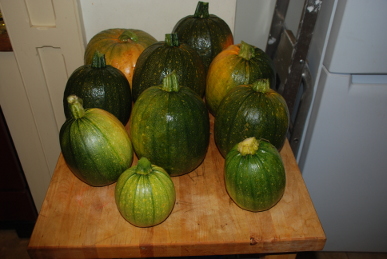
Sunday – Leominster – A busy few days! Another gallon of cider has been processed, this time using Dymock Red apples. There was a rather disgusting number of slugs on the fruit, we need a long period of hard frosts through the winter or else next year is going to be a slug nightmare! The first frost of the year touched the park this morning. As it was actually forecasted last night, the pumpkins were harvested yesterday, a total of ten. The French beans were removed, a decent amount of drying beans collected. Some of the sweetcorn were removed, again a reasonably successful crop, like the pumpkins a first! Garlic needs to be planted, so the ground from which the sweetcorn came needs to be prepared. I also need to visit the cider apple trees again regularly over the next few days as there are a lot of apples on the ground. The weather has not been helpful over the past week. Frequent showers make it difficult to get out and close the garden down for the winter, although Kay does most of that work. One of the hens has been looking poorly for a week or more now and sadly died a few days ago. The remaining hen looks rather lonely, so I will need to get some companions shortly. We are in a quandary as to whether to stick to Warrens, which are very productive but not very hardy or else get some of the stronger hybrids.
Monday – Home – The weather remains so changeable. There has been rain and sunshine today, often in quick succession. Another rucksack full of apples, Herefordshire Redstreak are gathered and pressed. The peanut feeder is busy – Blue and Great Tits are constantly coming and going, then a Nuthatch turns up. It hangs upside down and attacks the nuts with its powerful beak.
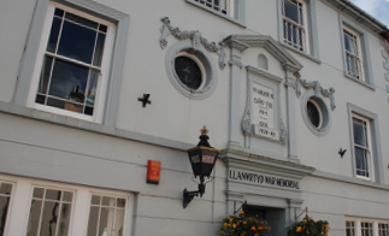
Tuesday – Llanwrtyd Wells – A small town on the River Irfon, indeed a plaque on the War Memorial Institute claims it to be the smallest town in Britain. A mixture of sturdy terraced cottages and Victorian villas line the streets. The tale of the town is that it was a tiny village with a church until, in 1732, one Theophilus Evans, vicar of Llangammarch Wells, was afflicted with incurable scurvy. A couple of miles up the valley from the church was the Ffynnon drellwyd, or “stinking spring”, a sulphur spring. The good Reverend visited the spring and observed a frog jumping into the centre of the well formed by the spring and far from being poisoned, seemed to delight in the noxious waters. So the Reverend decided to try the waters, applied both externally and internally and was cured of his affliction. The spring became known to society, not the least to Lady Hester Stanhope and the village, which had a station, grew and prospered. Up Victoria Street which leads toward the Victoria Wells. The houses are fine Victorian villas and, looking in a local estate agents, remarkably cheap! The New Hall is now a hotel. Opposite, the River Irfon is wide and shallow, bubbling over a rocky bed. A large statue of a Red Kite stands in the town square and on cue the real thing soars over the hills beyond the town. The Neuadd Arms is a large hotel built around 1880s. Police station still has its blue lamp. Britannia House claims fame as the place where the song “Sospan Fach” was composed by visitors from the west Wales industrial towns. Famously sung by tin-plate workers from Llanelli, it is now a rugby anthem.
Llandovery – A typical market town on the old drovers’ trail from west Wales to London. It is noticeable how many places have restaurants or hotels called The Drover, indeed our B&B is thus called. The settlement dates back to at least Roman times when it was the junction of roads to Carmarthen, to Brecon and to goldmines at Dolaucothi. A fort stood on Llanfair Hill to the  north-east of the town, which was called Alabum. A castle stands on a high mound behind the houses and shops on the main A40 which runs through the town. Just beyond is the Afon Brân, the River Brân. Red Kites call and sail over. Like most castles in Wales it has a turbulent history. In 1116, the Norman, Richard Fitz Pons built the motte and bailey, then known as the “Castle of Cantref Bychan.” Shortly thereafter, the Welsh, led by Gruffydd ap Rhys, attacked and destroyed the outer bailey. The Normans retained control of the castle until 1158, when the Lord Rhys successfully captured it from Walter Clifford. Over the next several years, control of Llandovery Castle both alternated between the Welsh and the English, and between the Welsh when the heirs of Lord Rhys (including Rhys Gryg and Maelgwyn) fought each other for their father’s possessions. In 1277, Llandovery Castle was taken by Edward I and the English continued to control the stronghold, with a brief exception in 1282 when Llywelyn the Last took possession, until it was slighted after the Civil War and fell into ruin. There are a surprising number of pubs and, although most closed at lunchtime, they look like they open in the evening. Mind, the price of beer here means they ought to be profitable. The King’s Head was once a bank, the Welsh Bank of the Black Ox, established by a wealthy drover. Our B&B is in an elongated market square with a solidly built market and town hall built in 1857 replacing a wooden structure dating from the granting of a market charter in 1495. A large fountain splashes merrily.
north-east of the town, which was called Alabum. A castle stands on a high mound behind the houses and shops on the main A40 which runs through the town. Just beyond is the Afon Brân, the River Brân. Red Kites call and sail over. Like most castles in Wales it has a turbulent history. In 1116, the Norman, Richard Fitz Pons built the motte and bailey, then known as the “Castle of Cantref Bychan.” Shortly thereafter, the Welsh, led by Gruffydd ap Rhys, attacked and destroyed the outer bailey. The Normans retained control of the castle until 1158, when the Lord Rhys successfully captured it from Walter Clifford. Over the next several years, control of Llandovery Castle both alternated between the Welsh and the English, and between the Welsh when the heirs of Lord Rhys (including Rhys Gryg and Maelgwyn) fought each other for their father’s possessions. In 1277, Llandovery Castle was taken by Edward I and the English continued to control the stronghold, with a brief exception in 1282 when Llywelyn the Last took possession, until it was slighted after the Civil War and fell into ruin. There are a surprising number of pubs and, although most closed at lunchtime, they look like they open in the evening. Mind, the price of beer here means they ought to be profitable. The King’s Head was once a bank, the Welsh Bank of the Black Ox, established by a wealthy drover. Our B&B is in an elongated market square with a solidly built market and town hall built in 1857 replacing a wooden structure dating from the granting of a market charter in 1495. A large fountain splashes merrily.
Wednesday – Llandovery – Over to stock yard where Maddy can chase her glowing ball in the dark. The sky is starlit but somehow it still manages a few drops of rain. Maddy knocks her ball in the sheep pens and stands in one staring intently at the glowing orb, which is in a pen two away. She fails to work out she can simply walk out of one pen and into the other. Through the town and up a hill to Llanfair ar y Bryn, the Church of Mary on the Hill. The Roman fort stood on this site but there is no trace. The fields drop away to a valley with gentle hills heading north. Sir Roderick Impey Murchison studied the geology of Llandovery which led to an epoch of the Silurian period being named the Llandovery Group, lasting from 443 to 438 million years ago. Alarm calls from Blackbirds are coming from all directions. A Common Buzzard mews from across the valley. Other squeaks and chirrups are enjoined by cawing Rooks and a fitfully singing Robin. The sky is lightening and large white cumulus clouds drift in. The wind begins to gust. A little later a rainbow arches across dark clouds.
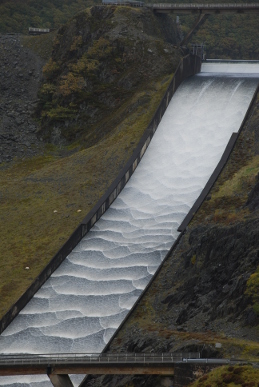
Llyn Brianne – A long winding road leads up the Towy valley to this huge reservoir in the hills. The 300 foot high dam was constructed by Wimpey of clay and crushed rock and completed in 1973. A long spillway flows with water which makes wonderful patterns. A hydro-electric generator can make up to 4.3 megawatts of power. Nearby is the RSPB Gwenffrwd-Dinas
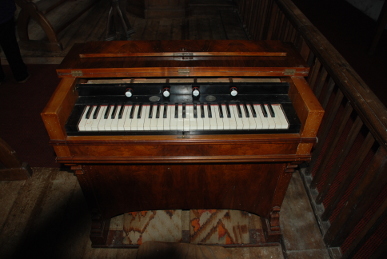 reserve. A boardwalk leads out across a wetland of Alders and Willows growing in a maze of streams flowing down to the Towy which is rushing through the hills a short distance away. Bird life is limited now, this is a reserve famous for its summer visitors, especially Wood Warbler, Pied Flycatcher and Redstart. Umbellifer skeletons lay in the water, we cannot identify the remains. Many trees are covered in lichens and moss, larger Oaks have ferns growing out of their bark. A fallen tree is riddled with Honey Fungus. Just outside of the reserve is the church of St Paulinus or Pawl Hen, a 6th century head of Whitland College, whose pupils included St David and St Teilo. The church is a delightfully plain building with equally simple but beautiful wooden pews, lectern, altar and pulpit. A lovely little harmonium sits opposite the lectern. A coffin carrier is above the vestry. The church was, apparently, a much larger and more ornate affair built according to legend in 1117 but was wholly rebuilt in 1821 by Lord Cawdor and restored in 1900 by his descendent. Frederick Vaughan, Earl Cawdor.
reserve. A boardwalk leads out across a wetland of Alders and Willows growing in a maze of streams flowing down to the Towy which is rushing through the hills a short distance away. Bird life is limited now, this is a reserve famous for its summer visitors, especially Wood Warbler, Pied Flycatcher and Redstart. Umbellifer skeletons lay in the water, we cannot identify the remains. Many trees are covered in lichens and moss, larger Oaks have ferns growing out of their bark. A fallen tree is riddled with Honey Fungus. Just outside of the reserve is the church of St Paulinus or Pawl Hen, a 6th century head of Whitland College, whose pupils included St David and St Teilo. The church is a delightfully plain building with equally simple but beautiful wooden pews, lectern, altar and pulpit. A lovely little harmonium sits opposite the lectern. A coffin carrier is above the vestry. The church was, apparently, a much larger and more ornate affair built according to legend in 1117 but was wholly rebuilt in 1821 by Lord Cawdor and restored in 1900 by his descendent. Frederick Vaughan, Earl Cawdor.
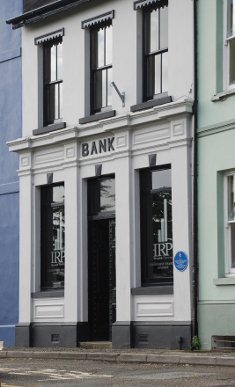
Llandeilo – A delightful town high on a bluff overlooking the River Towy. Like the other towns heading towards Carmathen it lay on the drovers’ trail. The town is named after St Teilo and was always called Llandilo, but official decree changed the name to make the reference to St Teilo more obvious. St Teilo was a contemporary of St David and could easily have become the patron saint of Wales instead of David. The main street rises and falls over the hillside. It is full of interesting buildings of many different styles. A sign over an alleyway declares the entrance to the “Public Hall and Literary Institute Reading Room and Library”, now residing in a more modern building. To remind one this is still rural Wales, a young woman rides up the hill on horseback leading another horse. The HSBC Bank is a fine Victorian building and the previous “Midland Bank” sign can can be made out on the fascia. Opposite, Lloyds TSB is a much finer affair with a split pediment in Georgian style and a tall, ornate tower. Up on a terrace above the churchyard is a building, now an office, is a building marked “Bank”. This was a Black Ox Bank which issued Llandeilo bank notes. Next door a sign on the wall, “Nag’s Head Inn” has been painted out. On up the hill past the Davies Memorial Hall of 1874, to Abbeyfield House, an imposing Georgian building formerly an inn, then a vicarage. Troops were billeted there in 1840 during the Rebecca Riots. Back down the hill and round past the abbey to Crescent Road where the land drops steeply away to the plain of the River Towy. Allotments cling to the side of the hill. We decide we need to return to this town as there is still more to see.
Dinefwr Castle – Dinefwr Park and Castle lay to the north of Llandeilo. There is a large 17th century house – Newton House and an extensive deer park but today we walk in the opposite direction, down the hill and then up through Castle Woods which were saved with the castle by the diligence of Ian Watt, a forester and member of the Wildlife Trust, who launched a  public appeal so the Trust could purchase the site. The castle stands on a ridge with extensive views. Mediaeval Welsh texts state this site was the principal court of the Kingdom of Deheubath. The castle however, does not seem to have any history prior to Rhys ap Gruffydd, the Lord Rhys in the 12th century. The castle passed to Rhys’ son Rhys Gryg and the earliest parts of the castle may date from this period, the late 1190s. However, Llywelyn the Great of Gwenydd expanded into the area and Rhys dismantled the castle. Llywelyn rebuilt it and held the castle until his death in 1240. Edward I captured it in 1277. The castle passed through English hands including Hugh Dispenser and was held by Rhys ap Thomas by the end of the 15th century. The Rhys (now Rice) family built Newton House and abandoned the castle which was redeveloped in the late 17th century as a summer house. A Raven cronks as we approach the castle through Castle Woods. We climb the steps to the circular keep but the gale force wind drives us back. I then climb the winding staircase to the top of the northern tower and was, frankly pretty terrified standing in a blasting wind with acute vertigo but I linger long enough to appreciate the strategic position of the site from which miles of the Towy valley and surrounding hills can be watched.
public appeal so the Trust could purchase the site. The castle stands on a ridge with extensive views. Mediaeval Welsh texts state this site was the principal court of the Kingdom of Deheubath. The castle however, does not seem to have any history prior to Rhys ap Gruffydd, the Lord Rhys in the 12th century. The castle passed to Rhys’ son Rhys Gryg and the earliest parts of the castle may date from this period, the late 1190s. However, Llywelyn the Great of Gwenydd expanded into the area and Rhys dismantled the castle. Llywelyn rebuilt it and held the castle until his death in 1240. Edward I captured it in 1277. The castle passed through English hands including Hugh Dispenser and was held by Rhys ap Thomas by the end of the 15th century. The Rhys (now Rice) family built Newton House and abandoned the castle which was redeveloped in the late 17th century as a summer house. A Raven cronks as we approach the castle through Castle Woods. We climb the steps to the circular keep but the gale force wind drives us back. I then climb the winding staircase to the top of the northern tower and was, frankly pretty terrified standing in a blasting wind with acute vertigo but I linger long enough to appreciate the strategic position of the site from which miles of the Towy valley and surrounding hills can be watched.
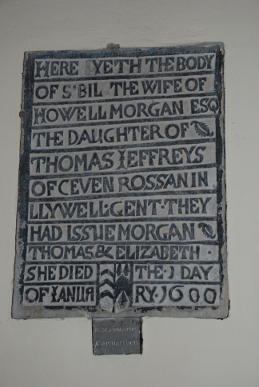
Thursday – Llywel – A farm and a church on the main road to Brecon. Mistle Thrushes rasp and fly out of a massive Yew. A Red Kite disappears over the hillside. The church of St David was noted by A.G. Bradley in his “Highways and Byways of South Wales” published in 1903 as “full of memorials of bygone families of note who once flourished in this high and narrow vale”. He remarks that “few or no gentry live thus far up nowadays”. The church is indeed fine with an unusual tiled reredos, made in brightly coloured tiles made by Godwin of Lugwardine, Herefordshire. The church has suffered a Gilbert Scott refurbishment, which included destruction of a rood loft. Most were removed by order of Henry VIII but some survived in remote sites. The door remains isolated high above the pulpit. This pulpit is beautifully carved by Harry Hems of Exeter in 1925. The same workshop produced the chancel screen in the style of that chopped up by Scott. Against the west wall is a 5th or 6th century stone, the Aberhydfer Pillar Stone, found on the nearby Roman Road. It has very crude Roman letters overlaid by Ogham script. Here also is a cast of the Llywel Pillar 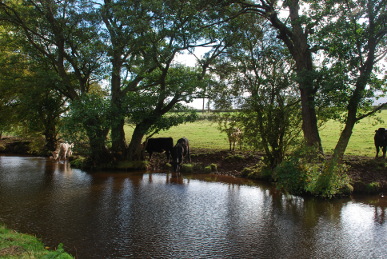 Stone, the original now in the British Museum, a 5th century memorial to an Irishman. Roman letters translate as “The stone of Maqutrenus Salicidunus”,the reverse is richly carved with figures and Ogham script is on the edges. The walls of the church hold many plaques as referred to by Bradley. One dates from 1600, remembering S’bil, wife of Howell Morgan Esq. Another seems to inscribe a family tree to the extent I am not sure exactly for whom it is the memorial! It dates from the late 17th century.
Stone, the original now in the British Museum, a 5th century memorial to an Irishman. Roman letters translate as “The stone of Maqutrenus Salicidunus”,the reverse is richly carved with figures and Ogham script is on the edges. The walls of the church hold many plaques as referred to by Bradley. One dates from 1600, remembering S’bil, wife of Howell Morgan Esq. Another seems to inscribe a family tree to the extent I am not sure exactly for whom it is the memorial! It dates from the late 17th century.
Brecon – We pay a short visit to Brecon before meeting Fran and Derek at Llanfrynach. After lunch we set off from a lock at Glanusk on the Monmouthshire and Brecon Canal and walk down to Storehouse Bridge. The canal is peaceful apart from Maddy’s antics with a stick (and I will point out it was Derek and Kay who managed to throw the stick into the water, resulting in a soaked dog!) The River Usk, often below the level of canal, is wild as it passes over weirs and rocks, particularly by Millbrook Mill. Great beef cattle come down to the water to drink. An old trunk plug is displayed by the tow-path. These were, apparently, used to drain the canal.
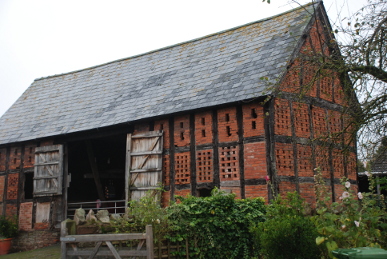
Thursday – Dinedor – From the city centre along the road that goes south, past one of the last remaining stretches of the city wall and over the River Wye. The river is slow and strewn with leaves. It is still very dull and damp. Past the old bridge on on east along the banks of the river. An installation by Mariele Neudecker called “A Thousand Ghosts”represents a half-sunken three mast ship. The river was navigable until the 1850s when the railways supplanted it. The path leaves the river and heads into suburbia. The Holme Lacey road continues east to Lower Bullingham. There are some older houses and an old barn leading to an abandoned church and residential home. A stream flows through a culvert next to an old black-and-white cottage and St Elizabeth’s Cottages, which gives a clue to the name of the church! Indeed, research shows this was St Elizabeth’s Covent of the Order of St Vincent de Paul. The Convent of Poor Clares was a little south of here. Up Lower Bullingham Lane and on to Watery Lane. The brook runs beside the road. The name of the lane suggests the brook floods and sandbags outside a nearby old house rather confirms this. Past a lovely Victorian barn at Watery Lane Farm and under the railway line. On the left is an industrial estate apparently housing a Brethren place of worship. Once there were orchards here. The wind rises, rustling the leaves of Poplar trees whose trunks are encased in flowering Ivy. The layout of the road is different from the OS map as the link road to Rotherwas is not shown.
The correct road is found and soon becomes a muddy path along Rough Hill, the lower 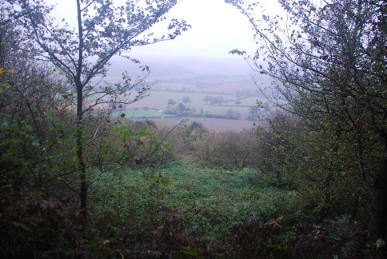 slopes of Dinedor Hill. Beside the path is a probably much older sunken track-way, now very overgrown. A Jay screeches. Many of the trees are Sweet Chestnut and the path is strewn with their husks, opened like stars with tiny chestnuts inside. The path turns back from muddy pools to asphalt when it reaches Camp Farm. Scarlet strings of Black Bryony berries adorn the hedgerow. Up past Well Cottage to Dinedor Camp. The camp is a late Iron Age hill-fort, built around the 1st century CE. It is likely to have been occupied by the Silures with the territory of the Dubunni to the north of the River Wye. Much raiding would have taken place across the river. The fort has high ramparts to the north and east, relying on the steep slope to the south for defence. Views to the south are of mist cloaked fields, the hills of Aconbury completely hidden. To the north, Hereford is also misty. A vast fallen Beech blocks the path on the north-west side. Carrion Crows are noisy. Clumps of Honey Fungus grow apparently out of grass but it is certain that an old stump is under the sod. Down Dinedor Common to the Hoarwithy Road which returns a mud-splattered Maddy and me towards the city. Through Green Grize, just a few cottages. Under the main line to Abergavenny and Newport, once the Great Western and London and North Western Joint Railway Abergavenny, Hereford and Newport Branch. Just beyond, Withy Brook flows under the road. Into Putson and down to the River Wye once more.
slopes of Dinedor Hill. Beside the path is a probably much older sunken track-way, now very overgrown. A Jay screeches. Many of the trees are Sweet Chestnut and the path is strewn with their husks, opened like stars with tiny chestnuts inside. The path turns back from muddy pools to asphalt when it reaches Camp Farm. Scarlet strings of Black Bryony berries adorn the hedgerow. Up past Well Cottage to Dinedor Camp. The camp is a late Iron Age hill-fort, built around the 1st century CE. It is likely to have been occupied by the Silures with the territory of the Dubunni to the north of the River Wye. Much raiding would have taken place across the river. The fort has high ramparts to the north and east, relying on the steep slope to the south for defence. Views to the south are of mist cloaked fields, the hills of Aconbury completely hidden. To the north, Hereford is also misty. A vast fallen Beech blocks the path on the north-west side. Carrion Crows are noisy. Clumps of Honey Fungus grow apparently out of grass but it is certain that an old stump is under the sod. Down Dinedor Common to the Hoarwithy Road which returns a mud-splattered Maddy and me towards the city. Through Green Grize, just a few cottages. Under the main line to Abergavenny and Newport, once the Great Western and London and North Western Joint Railway Abergavenny, Hereford and Newport Branch. Just beyond, Withy Brook flows under the road. Into Putson and down to the River Wye once more.
Saturday – Leominster – It is much colder and the sky is clear. During the earlier part of the night the moon was brilliant but now it has set and the stars are twinkling brightly. Jupiter is the brightest thing in the heavens, laying close to the Hyades. A satellite passes over winking, probably a rocket body tumbling and only catching the sun from one angle. It is really dark around the Millennium Park, I quickly lose sight of Maddy then observe a vague ghost ahead. The dry weather is welcome and some work can be done in the garden. A bed is cleared and garlic planted. Pots of compost are put in the greenhouse and broad beans sown. The glass of the greenhouse is washed down with a mixture of soft soap and Jeyes fluid. A couple of panes had to be replaced, one in the door that broke for some unknown reason and one that lies under a branch of the Bramley apple and was almost certainly smashed by a falling fruit. Apples are picked but they are very scabby and often split. It seems that conkers have finished falling from the great Horse Chestnut that rises over the summerhouse, but there are still huge numbers of leaves still to come down. Yesterday we went up to the chicken farm and purchased another hen. She has been called “Stevie McQueen” as she somehow escapes twice from the leaf mould cage she is placed in before introducing her to the other hen (see “The Great Escape..”) I place her in the hen house after dark and this morning they appear to be getting on well. And there are two eggs!
Monday – Mortimer Forest – The damp and grey returns. Into the woods to the sound of a nearby Great Spotted Woodpecker and a distant Jay. Deeper into the forest, rising up the hill towards the long Forestry track, there is silence. It is occasionally broken by a brief squeak from a Blue Tit or a far off Carrion Crow barking. Silver Birch leaves are now yellow and falling. Skeletons of umbellifers stand gaunt and brown. Bracken is brown but Coltsfoot remains green, although brown spots are beginning to appear. Approaching the Larch plantation, the track turns golden-brown with a covering of fallen needles. The Clee hills are capped by cloud and thin, misty wisps drift along the Teme valley. The day begins to brighten with patches of blue sky and sunshine filtering through the trees.